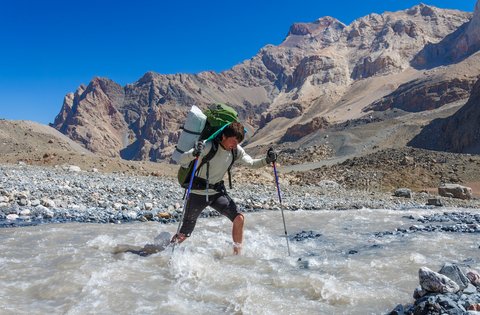Now that spring is here (I hope), many of us are heading out to our favorite hiking trails. Here in the west, after a well needed wet winter, streams and rivers are higher than they’ve been for years, resulting in higher risks for water related accidents. There are a few techniques to keep in mind before you cross a quick-flowing waterway.
At first glance it may appear that the current is similar in all spots but the reality is that current is affected by depth and all of the obstacles under the water. Just seeing rapids doesn’t necessarily mean that the current is swift. It may be shallow (the best place to cross) and look more treacherous than it actually is. It is important to look closely at the proposed crossing site before jumping in. If you can get a higher vantage, you will be able to see the bottom better.
Many hikers carry trekking poles and when it comes to fording rivers, it’s like having two more legs. Always carry at least one strong stick when attempting to cross. Also, you can use the stick to test the flow ahead of you and use it as a downstream brace in more quick currents. In muddier water, a stick can provide a good probe to check for debris or deep holes as you cross.
Many people cross a river at a 90 degree angle and that’s fine if you are following a jeep trail. In this case, staying on the trail is probably your best bet (watch out for deep tire trenches). But if you’re away from roads, it’s best to cross at an angle. Crossing at an angle causes less friction and makes you less likely to loose your footing. Let the current help you if possible.
You should always be aware of your load. Unclip your waist strap on your backpack so you can quickly get rid of it if you get swept away. Although you don’t want to get your boots wet, it is important to keep them on for traction and to help avoid injury. Many hikers carry a pair of tennis shoes. By all means, don’t go barefoot unless it’s shallow, sandy and has a calm current.
When you’re scouting out a good spot to cross, sometimes you will notice animal tracks. Look at where these tracks cross. If animals choose it, it’s probably a good choice. Cross one at a time to make sure someone is there to help in case of an accident and be sure to mark your crossing for your trip back. Rivers can change quickly and you might not be able to find your spot again.
Lastly, if you do get swept off your feet, continue downstream with your legs ahead of you. Try to stay calm and work your way at an angle to the nearest shore using your feet to help guide you. You have a better chance of avoiding injury if you stay on your back and use your arms to paddle and stay afloat.
Many people drown each spring due to rapid water that is very cold. It’s always critical to closely consider the best option. Sometimes spending a little more time looking for a safer crossing or even a sturdy log to shimmy across will ensure you have a safe and enjoyable trip.
© Rov1609 | Dreamstime.com – Hiker crossing mountain river








